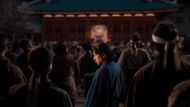Last Samurai Standing dropped on Netflix on November 13, 2025. The hype was already brewing months before, thanks to its first two episodes getting prime spotlight at the 30th Busan International Film Festival.
The series has only six episodes, each clocking in around 50 minutes, but there is enough meat on the bone to get you hooked.
It is set in 1878 Japan, when the samurai era is basically gone, and everybody is out of a job, and 292 ex-samurai are totally lost. They get thrown into a brutal survival contest. It is a crazy trek from Kyoto to Tokyo, and only one of them gets to walk away with a fat stack of cash.
Junichi Okada is playing Shujiro Saga. Last Samurai Standing is a mash-up of action, historical fiction, and heavy-duty psychological drama. There is blood and blade, but it is also about people trying to figure out who they even are now that everything has changed. You get desperation, pride, and some really ugly sides of human nature.
Key filming locations of Last Samurai Standing

As per 4filming, most of Last Samurai Standing was shot right in Kyoto, Japan. The show kicks things off at Tenryū-ji Temple, in the middle of Arashiyama’s pretty scenery. They didn’t just use it for a couple of shots. That is the main stage, where about 300 samurai all gather to start their whole wild adventure.
The fact that it is a real, centuries-old temple, not CGI, elevates the authenticity.
Tenryū-ji Temple isn’t the only Kyoto gem getting screen time in Last Samurai Standing. The crew wandered all over Kyoto. If there was a spot that screamed Meiji era, you can bet they had a camera rolling there. The producers cram in as much real, gritty Kyoto as possible.
Additionally, all the official chatter keeps circling back to Tenryū-ji. There are no reports to confirm whether they filmed in Tokyo or Himeji, or anywhere else. It is all Kyoto, through and through.
That means while the story is about people heading to Tokyo, the crew actually recreated a bunch of those travel scenes right in Kyoto. They used local spots to stand in for all sorts of places. This is apparently the norm for period dramas. Why drag everyone to a new location if you already have Kyoto with a mix of old-school architecture? It keeps things looking seamless and saves them a boatload of cash.
What is Last Samurai Standing about?
Last Samurai Standing opens in 1878, right after the samurai glory days crashed and burned. Japan is a total mess, with old-school warriors not allowed to carry swords or enjoy their perks anymore. So these ex-samurai and a couple of clever women sneaking in are broke, dodging sickness, and watching their whole world get flipped upside down thanks to the Meiji government’s new reforms.
Then out of nowhere, 292 of them get a mysterious invite to Tenryū-ji Temple in Kyoto. They show up, get handed wooden tags, and turns out they are signed up for the Kodoku tournament. It is basically a kill-or-be-killed free-for-all. The last one standing pockets a mind-blowing 100 billion yen if they can make it to Tokyo.
The protagonist, Shujiro Saga (played by Junichi Okada), jumps into this mess because he is desperate for cash to help his sick wife and child. You have a wild crew alongside him too: General Oura (Hiroshi Abe), who is still clinging to his old-school samurai honor even though the world has clearly moved on; then there is Rin (Mayu Matsuoka), who is fighting tooth and nail for a shred of respect in a boys’ club that wants nothing to do with her; and Daigo Mori (Ryohei Suzuki), who is so power-hungry he would probably stab his own shadow if it got in his way.
The real fun is in watching everyone double-cross and team up, only to stab each other in the back five minutes later. The lines between “good” and “bad” get so smudged in Last Samurai Standing, you forget who you are rooting for. Every episode heightens the tension, whittling down the group, dragging everyone from peaceful countryside temples right into the noisy chaos of Tokyo. By the end, you are left wondering if anyone is actually going to make it out with their soul or just a fistful of yen.
Unlike usual samurai flicks where everyone is obsessed with honor and swinging swords, Last Samurai Standing digs way deeper into who really survives when stuff gets ugly. Who can actually live with what they have done? It is less about being the best with a blade and more about wrestling with your own messy choices. The series explores what loyalty even means, or how family can wreck you or save you, all while Japan is getting ripped apart by modernization.
Every episode of Last Samurai Standing feels like a punch to the gut with bloody fights, crazy camera work, and actors who look like they are actually about to break down on camera. You are watching people completely fall apart or pull themselves together in the middle of chaos.
